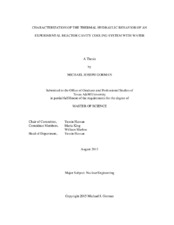| dc.description.abstract | An existing experimental Reactor Cavity Cooling System using water as the coolant received extensive instrumentation and control upgrades to allow for a thorough investigation into the single-phase flow behavior of the system under a variety of experimental conditions. Base level conditions used a uniform heat flux at a power level appropriately scaled from a benchmark computer simulation of the Gas Turbine Modular Helium Reactor (GT-MHR) using scaling relationships derived by Argonne National Laboratory. Experiments were setup to gauge the effects of flow throttling, non-uniform heat flux profiles, alternate power levels and alternate coolant inventory levels on the flow distribution in the Cooling Panel, and to investigate the relationships between system variables of applied power, the temperature difference across the Cooling Panel (ΔT) and flowrate. In addition, a single scoping experiment was executed to observe system performance with coolant at the saturation temperature.
The system variables proved to have highly linear relationships amongst each other under all experimental conditions. Flow instabilities were observed in the form of counter-phase sinusoidal oscillations of flowrate and ΔT, the frequency thereof showed a roughly linear relationship with power. Ultrasonic Velocity Profiling (UVP) was used to determine the flow distribution, which increased at the outlet side of the panel with either increased system flowrate or higher heat flux applied to the outlet side, and vice-versa. The effect caused by flowrate changes was the same whether due to a change in power level or throttling, indicating the fluid’s momentum is the driving factor.
The phenomenon of sudden, high velocity, short duration flow excursions, called geysering, was observed as the system coolant was brought to saturation. This was caused by the trapping of non-condensable gases in the top horizontal section of the flow loop, which in turn brought the flowrate down considerably, increasing residence time and temperature of the coolant in the Cooling Panel. Subsequent rise of saturated coolant to a higher elevation in the hot leg resulted in flashing of the coolant to steam, whose sudden expansion drove the flow excursion. | en |


